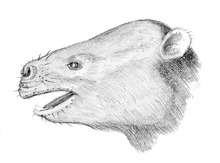Phosphatherium
| Phosphatherium | |
|---|---|
| Fossil | |
| Scientific classification | |
| Kingdom: | Animalia |
| Phylum: | Chordata |
| Class: | Mammalia |
| Order: | Proboscidea |
| Family: | †Numidotheriidae |
| Genus: | †Phosphatherium Gheerbrant, Sudre & Cappetta, 1996[1] |
| Species: | †P. escuillei |
| Binomial name | |
| Phosphatherium escuillei Gheerbrant, Sudre & Cappetta, 1996[1] | |
Phosphatherium escuillei is a basal proboscidean that lived from the Late Paleocene to the early stages of the Ypresian age [2] until the early Thanetian some 56 million years ago in North Africa. Research has suggested that Phosphatherium existed during the Eocene period [3]
Taxonomy

Phosphatherium is known primarily from two maxilla fragments dated to the latest Paleocene deposits of the Ouled Abdoun Basin, Morocco, which date from the Thanetian epoch. Not only is it one of the smallest (estimated to be about 30 cm tall at the shoulder and weigh about 17 kilograms)[4] member of the proboscidea family, but it is also the oldest in the family.[5] Like its later relative, Moeritherium, the animal was probably an amphibious browser that fed on aquatic plants, akin to a very small tapir. Both animals are included in the family Numidotheriidae, together with Numidotherium.
The specific name honors the discoverer French paleontologist François Escuillé.
Description

P. escuillei possessed rather flat features, centered around a low skull and a long, straight dorsal profile. The skull itself was rather disproportionate, consisting of an elongated cranial region and a rather short rostrum.[6] The sagittal crest, the ridge along the dorsomedian line of its skull, spans across nearly half of the skull itself. The nasal cavity is high and wide, suggesting a large snout in life.[6][7]
One of the main factors of Phosphatotherium's body is its non-traditional musculoskeletal system. The shape of its head is composed of attributes of a snout, more vividly, turning into a mouth with a rounded jawline. Similar mammals in its order retained a more snout like nose, which was also a factor that pertained to it having a semi-aquatic lifestyle. Furthermore, sexual dimorphism can be noticed on Phosphatotherium's face by a varying degrees of muscle attachments on its upper jaw.[8]
Phosphatotherium lacked a trunk. The tooth rows extend back to roughly 45% of its total skull length. The dental structures suggests that P. escuillei is a Heterodont, meaning it possesses more than one type of tooth morphology.[9] This is evident due to the fact that they possessed more than one type of molar upon fossil examinations. The various dental formations of Heterodonts suggest that this animal, unlike later proboscideans, may have been omnivorous.[10]
The unique traits of Phosphatherium teeth suggest them to be intraspecific. Some features of Phosphatherium escuilliei teeth and jaw structures also show noticeable variation, which is related to sexual dimorphism. This suggests there were physiological differences between male and females, which ultimately suggests behavioral differences.[11]
Palaeobiology
Phosphatotherium is thought to have had a broad diet. The dental microwear patterns observed on the teeth of Phosphatotherium show lengthy scratches on the molars of juveniles. Correspondingly, similar patterns are also found on adult individuals. Through study of the wear and specifically scratches on the teeth of Phosphatotherium, the food items it ingested include shrubs and bushes, indicating a mixed feeding preference. Adult molars are found to have a much higher density of scratches, indicating abrasive food sources and possibly insects and small animals. Overall, Phosphatotherium is thought to be an omnivorous browser mainly determined by its preferences as well as the availability of resources.[12]
Considering its highly adapted folivorous jaw and tooth structure, Phosphatherium provides evidence of the high age of African endemism. The dental structure of Phosphatherium suggests its diet to consisted mainly of leaves, which indicates it may have fulfilled a niche role in its environment, although diet can only be inferred through speculation. The discovery of this animal has ultimately helped reinforce the African origin of proboscideans, and provide insight into the radiation of modern orders of placental mammals.[13]
References
- 1 2 Gheerbrant, E.; Sudre, J.; Cappetta, H. (1996). "A Palaeocene proboscidean from Morocco". Nature. 383 (6595): 68–71. doi:10.1038/383068a0.
- ↑ http://www3.planetarioroma.it/content/download/4908/62991/file/637_638.pdf.
- ↑ http://www.biomedcentral.com/1471-2148/7/224
- ↑ Larramendi, A. (2016). "Shoulder height, body mass and shape of proboscideans" (PDF). Acta Palaeontologica Polonica. 61. doi:10.4202/app.00136.2014.
- ↑ http://bsgf.geoscienceworld.org/content/174/3/279.short.
- 1 2 Gheerbrant, E; Amaghzaz, M; Bouya, B; Goussard, F; Letenneur, C (2014). "Ocepeia (Middle Paleocene of Morocco): the oldest skull of an afrotherian mammal". PLOS ONE. 9: e89739. doi:10.1371/journal.pone.0089739. PMC 3935939. PMID 24587000.
- ↑ Ferretti, Marco; Debruyne, Regis (2010). "Anatomy and Phylogenetic Value of the Mandibular and Coronoid Canals and Their Associated Foramina in Proboscideans (Mammalia)". Zoological Journal of the Linnean Society. 161 (2): 391–413. doi:10.1111/j.1096-3642.2010.00637.x.
- ↑ Gheerbrant, Emmanuel; Sudre, Jean; Tassy, Pascal; Amaghzaz, Mbarek; Bouya, Baâdy; Iarochène, Mohamed (2005). "Nouvelles données sur Phosphatherium escuilliei (Mammalia, Proboscidea) de l'Eocene inférieur du Maroc, apports à la phylogeny of the Proboscidea et the ongulés lophodontes". Geodiversitas. 27 (2): 239–333.
- ↑ https://www.app.pan.pl/archive/published/app47/app47-493.pdf
- ↑ http://web.clark.edu/sclark/Mammals%20Writings/Characteristics%20of%20Mammals.pdf
- ↑ Gheerbrant, E. ( 1 ), et al. "New Data On Phosphatherium Escuilliei (Mammalia, Proboscidea) From The Early Eocene Of Morocco, And Its Impact On The Phylogeny Of Proboscidea And Lophodont Ungulates." Geodiversitas 27.2 (2005): 239-333.
- ↑ "Feeding preferences of Gomphotherium subtapiroideum (Proboscidea, Mammalia) from the Miocene of Sandelzhausen (Northern Alpine Foreland Basin, southern Germany) through life and geological time: evidence from dental microwear analysis". Paläontologische Zeitschrift. 84: 205–215. doi:10.1007/s12542-010-0054-0.
- ↑ Gheerbrant, Emmanuel (1998). "The Oldest Known Proboscidean and the Role of Africa in the Radiation of Modem Orders of Placentals". BULLETIN OF THE GEOLOGICAL SOCIETY OF DENMARK. 44: 181–85.
- "Phosphatherium escuillieidu Thanétien du Bassin des Ouled Abdoun (Maroc), plus ancien proboscidien (Mammalia) d'Afrique". Geobios. 31: 247–269. doi:10.1016/S0016-6995(98)80041-7.
http://mygeologypage.ucdavis.edu/cowen/historyoflife/Phosphatherium.html